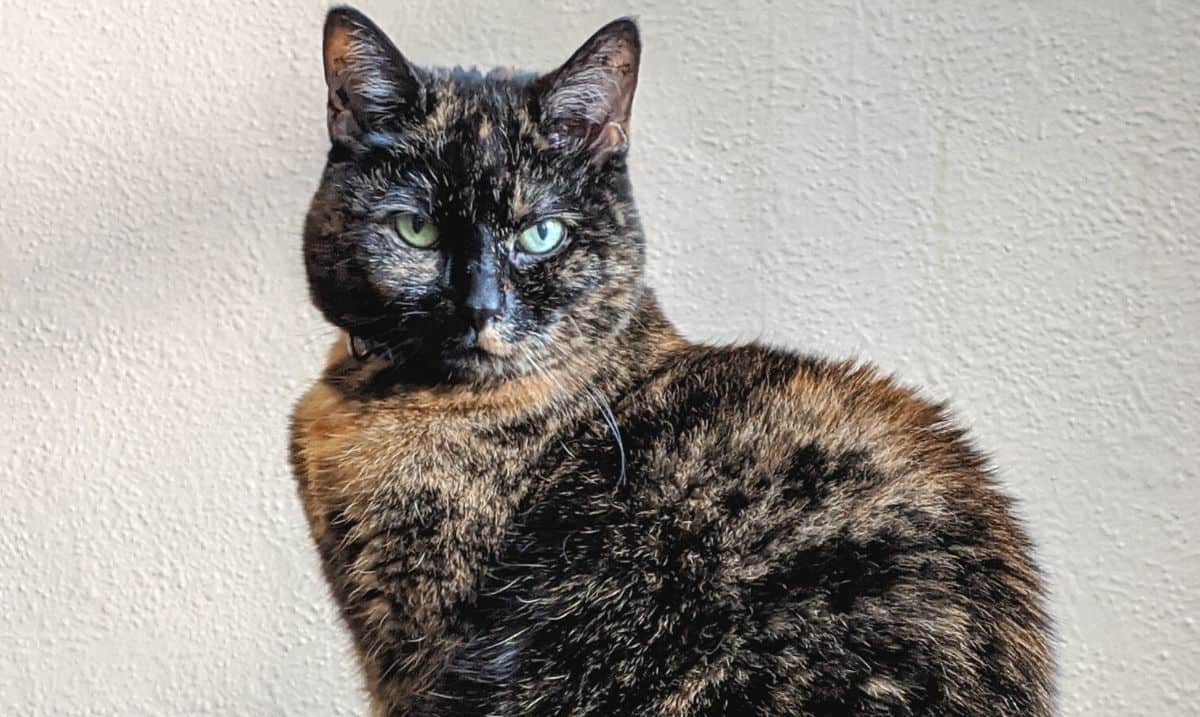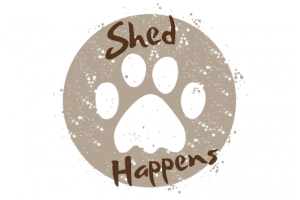Is Tortitude Real? The Truth About Tortoiseshell Cats
Tortoiseshell cats (or ‘torties’) are often known as the ‘divas of the cat world’. But how does one earn a title like that? Ask any tortie lover and they will instantly point to their big, strong-willed personalities! Is tortitude real? Let’s take a look at this feisty attitude and whether there is some truth to this well-known claim…
What is it about the Tortie that continues to attract the attention of cat lovers around the world?
One could argue that their distinctive coats are enough to captivate those with an eye for beauty, but there is so much more to these adorable cats.
In fact, those who fall under their spell will tell you that life is anything but boring when you share it with a tortie!
Just ask the 8,000+ members of the Facebook group ‘Tortie Lovers United’.
Personally, I share my heart and home with 2 adorable (and spunky) torties, Pippen and Jinx (featured in the photo above).
If you follow Shed Happens on social media, then you already know that these two keep us on our toes more often than not!
They are vocal, curious, stubborn and demanding… But we wouldn’t trade it for the world!
Related: ‘Is Catnip Good for Cats?‘
What is a Tortoiseshell Cat?
Let’s start by clarifying right away that ‘Tortoiseshell’ is NOT a specific breed of cat.
Instead, it refers to a specific coat colour and fur pattern that can be seen occurring in a variety of different breeds (including mixed breed cats).
Breeds associated with this colouring include both British and American Shorthairs, Maine Coons and Persians.
Their name comes from the appearance of their coat, which resembles the colouring of the tortoiseshells which were once widely used in everything from jewellery to furniture.
Their coats are a combination of colours, most commonly black and red, with little or no white markings and can be seen in both short-haired and long-haired varieties.
Variations to the traditional tortie coat include:
- Dilute Torties: Torties that have a similar coat pattern to the traditional tortie, however, the colouring is muted with greys and creams.
- Torbies: Cats that have a combination of the tortoiseshell coat with tabby stripes.
- Calicos: Tri-Colour cats, combining the two-tone colouring of the tortie with white.
Interestingly enough, almost all torties are female…
The genes necessary for the tortoiseshell appearance is carried on the female chromosome (X) and a cat would need to have two X chromosomes for the tortoiseshell fur.
However, approximately 1 in 3,000 torties are male, the result of a genetic mutation.
Unfortunately, this same mutation generally results in a sterile cat that may struggle with health complications throughout their lives.

The History of Tortoiseshell Cats
While some cat breeds and colourings have emerged in recent years, the tortoiseshell is well documented throughout history.
In several different cultures, these beautiful cats are viewed as being good luck.
Celtic folklore tells of the good fortune and prosperity that torties would bring to their owners.
In fact, in the United States, tortoiseshell cats are sometimes referred to as ‘money cats’ as this folklore found it’s way into North America.
Meanwhile, in Japan, torties were often brought onboard fishing boats to protect the crew from the risk of shipwrecks and the ghosts that they may encounter out at sea.
What is Tortitude? Is Tortitude Real?
One of the most common discussions surrounding the tortoiseshell cat is the infamous ‘tortitude’.
The term ‘tortitude’ refers to the feisty, strong-willed personality that is often attributed to these cats by owners, veterinary professionals and shelter workers.
Torties are often described as being stubborn, determined, demanding and fiercely loyal to their owners.
They are also believed to be highly energetic and, in many cases, quite vocal.
But is this true?
The easy answer is that there isn’t solid scientific proof linking the tortoiseshell colour to the personality traits mentioned.
However, a study conducted by behavioural expert Dr. Elizabeth Stelow in the UC Davis Veterinary Medical Teaching Hospital found that torties are ‘more likely to hiss, chase, bite, swat or scratch during interactions with humans’.
However, she went on to assure that her findings weren’t shared to discourage people from bringing torties into their homes.
It’s merely a glimpse into their personalities which may be a great fit if you’re looking to share your life with one of these ‘little divas’.
They’re fiery. They’ve got a little spirit and zip to them. If you want a cat that will keep you on your toes, a calico or tortie is the way to go.
Gina knepp, front street animal shelter manager
What do I think? Let me take a moment to share from personal experience…
As I mentioned earlier, we currently share our lives with 2 torties, Jinx and Pippen.
Reading through the various definitions of ‘tortitude’ while writing this, I couldn’t believe how accurate they were when considering our two.
Pippen is our little Diva, the queen of our household here and the other pets all know it!
When she goes to drink from the water fountain, our large dogs step back and give her space to do as she pleases.
She likes to be pet when she wants to be pet, meowing softly and rubbing against your legs for strokes and belly rubs.
However, don’t even think of trying to pick her up or pet her when she’s not in the mood!
Related: ‘Easy Homemade Cat Treats with Pumpkin‘
Around our house, Jinx has the nickname ‘the terrorist’. Why? If something happens in this house, she’s behind it 99.9% of the time.
She is SUPER vocal, telling us off if she feels like she’s being ignored.
If she wants to be pet, she will be right up in your face demanding of your attention… But don’t ignore her unless you want to be nipped.
That being said, both cats happily greet us every time that we come home, and they both come running when their name is called (talking to us the whole way).
They are little kittens at heart, playful and high energy any time of day.
So, do I believe that tortitude is real? You bet I do!
And I wouldn’t trade it for the world…

Do you share your life with a tortie? If so, I’d like to hear your answer to the question ‘Is tortitude real’ as well as any fun stories you have about your adorable divas!



I always thought that ‘tortitude’ was just a myth and that coat patterns don’t affect personality, but it’s interesting to read that there could be some truth in it! I have never had a tortoiseshell cat, I’ve only had black and white and tabby cats. But I’d love to have a tortie in the future, and I’d be interested to see if she has ‘tortitude’!
I always thought that it was a myth too until I gave my life to torties. They are my weakness, I admit, and bringing them into my home was when I realized that they all fit the stereotype in their own way haha
We recently saved a small kitten , as she gets older I am seeing what they are meaning tortitude. She she is loving , stubborn, hard headed and does what she wants to do , regardless what we tell her. If I had known this I probably wouldn’t have adopted her. She’s a rat…?
It’s interesting how common the “tortitude” personality is among these cats. Of our two, Pippen is actually quite sweet, but Jinx is DEFINITELY a stereotypical tortie in every way!
Ah I had the cutest tortoise shell kitten as a child and he was so lovely! I’d love to get a kitten now that I have my own house but my fiance is dead against it! Boo!
Rosie
Boo! Is there a reason that he’s against it? If it’s allergies, I can understand, but if he’s just not a cat person he may warm up to the idea if it’s ‘your’ cat and you are responsible for everything that comes with it.
I had an awesome Torbie, for fourteen years. She was definitely a Diva, and would run to the door, talking loudly whenever someone rang the bell or knocked. When I spoke on the phone with a friend, she would give me a certain amount of time before meowing until I got off the phone so I could pay attention to her. When I had friends over, she would meow until I pulled up a chair for her, too! I miss her so much! I have two meek Tabby girls now, whom I love in a different way, but man, I miss the tortitude!
The tortitude definitely makes life interesting, doesn’t it? We have 2 torties here right now and between the two of them, life in our house is never boring!
I rescued a cat that was dropped off at Pet smart. She’s very skittishly and won’t come downstairs. I have the litter box and food up there. She came down a couple of times but ran upstairs when she heard noise. She looks like she was well taken care of but she so scared I don’t know what situation she came from. It’s been almost two weeks now should I just leave her there? I go up after supper and interact with her.
It can definitely take time – lots of time – to settle into their new surroundings. Here are a couple of articles from the site that I recommend reading through as they could help you during this stage:
14 Tips for Bringing Home a Rescue Cat – https://shedhappens.net/tips-for-bringing-home-a-rescue-cat/
The 3-3-3 Rule for Bringing Home a Rescue Dog – https://shedhappens.net/3-3-3-rule-bringing-home-a-rescue-dog/ (while written about dogs, the same 3-3-3 concept also applies to rescue cats)
I hope that gives you a good starting point! Don’t be afraid to drop any additional questions you might have and I will help in any way I can.